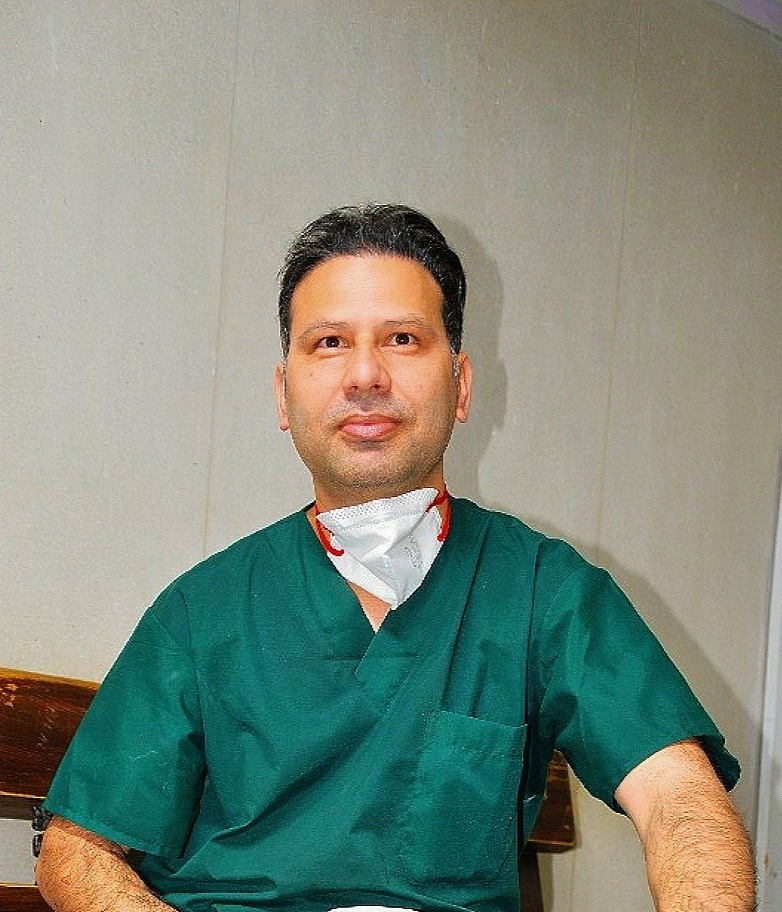Dr Farooq Ahmad Ganie (Assistant Professor Department of Cardiovascular and Thoracic Surgery Skims Soura)
Varicose veins are swollen and enlarged veins. They are often blue or dark purple and lumpy, bulging, and twisted in appearance. They occur on the legs and feet. Not all varicose veins bulge to the surface; sometimes they can be invisible and buried deep in the tissueTherefore, some people experience pain and discomfort for a long time before discovering the cause it happens when the valves in the veins do not work properly, so the blood does not flow effectively The exact pathophysiology is debated, but it involves a genetic predisposition, incompetent valves, weakened vascular walls, and increased intravenous pressure. Risk factors include family history of venous disease; female sex; older age; chronically increased intra-abdominal pressure due to obesity, pregnancy, chronic constipation, or a tumor; and prolonged standing. Symptoms of varicose veins include a heavy, achy feeling and an itching or burning sensation; these symptoms worsen with prolonged standing. Potential complications include infection, leg ulcers, stasis changes, and thrombosis.( blood clot in veins). In severe cases, a varicose vein may rupture, or develop into varicose ulcers
Diagnosis: To diagnose varicose veins, your doctor will do a physical exam, including looking at your legs while you’re standing to check for swelling. Your doctor may also ask you to describe any pain and aching in your legs.You also may need an ultrasound test to see if the valves in your veins are functioning normally or if there’s any evidence of a blood clot. In this noninvasive test, a doctor runs a small hand-held device (transducer), about the size of a bar of soap, against your skin over the area of your body being examined. The transducer transmits images of the veins in your legs to a monitor, so a doctor can see them.
The veins need treatment if there is swelling, aching, painful legs , venous ulcer and if there is considerable discomfort,or varicose ulcers
Treatment: Conservative treatment options include external compression; lifestyle modifications, such as avoidance of prolonged standing and straining, exercise, wearing nonrestrictive clothing, modification of cardiovascular risk factors, and interventions to reduce peripheral edema; elevation of the affected leg; weight loss;
Self-care — such as exercising, losing weight, not wearing tight clothes, elevating your legs, and avoiding long periods of standing or sitting — can ease pain and prevent varicose veins from getting worse
Compression stockings: Wearing compression stockings all day is often the first approach to try before moving on to other treatments. They steadily squeeze your legs, helping veins and leg muscles move blood more efficiently. The amount of compression varies by type and brand. You can buy compression stockings at most pharmacies and medical supply stores Or online.
treatments for more-severe varicose veins remains surgical: Although open surgery was once the standard of care, it largely has been replaced by endovenous thermal ablation, which can be performed under local anesthesia and may have better outcomes and fewer complications than other treatments
Fortunately, now the surgical treatment usually doesn’t mean a hospital stay or a long, uncomfortable recovery. Thanks to less invasive procedures, varicose veins are generally being treated on an outpatient basis which is quite routine in our department at SKIMS
If you don’t respond to self-care or compression stockings, or if your condition is more severe, your doctor may suggest one of these varicose vein treatments:
Sclerotherapy. In this procedure, your doctor injects small- and medium-sized varicose veins with a solution or foam that scars and closes those veins. In a few weeks, treated varicose veins should fade.Although the same vein may need to be injected more than once, sclerotherapy is effective if done correctly. Sclerotherapy doesn’t require anesthesia and can be done in your doctor’s office.
Laser treatment. in laser treatments to close off smaller varicose veins and spider veins. Laser treatment works by sending strong bursts of light onto the vein, which makes the vein slowly fade and disappear. No incisions or needles are used.
Catheter-assisted procedures using radiofrequency energy. Endovenous Radio-Frequency Ablation (RFA) is a useful treatment modality for varicose vein disease primarily due to great saphenous insufficiency with marked symptomatic improvement and least recurrence.The post operative recovery is quick with a high patient acceptance. In RFA The doctor inserts a thin tube (catheter) into an enlarged vein and heats the tip of the catheter using either radiofrequency or laser energy. As the catheter is pulled out, the heat destroys the vein by causing it to collapse and seal shut. This procedure is the preferred treatment for larger varicose veins.
High ligation and vein stripping. This procedure involves tying off a vein before it joins a deep vein and removing the vein through small incisions. This is an in patient procedure for most people. Removing the vein won’t keep blood from circulating in your leg because veins deeper in the leg take care of the larger volumes of blood.
Ambulatory phlebectomy:Your doctor removes smaller varicose veins through a series of tiny skin punctures. Only the parts of your leg that are being pricked are numbed in this outpatient procedure. Scarring is generally minimal.
Endoscopic vein surgery. You might need this operation only in an advanced case involving leg ulcers if other techniques fail. Your surgeon uses a thin video camera inserted in your leg to visualize and close varicose veins and then removes the veins through small incisions.
Varicose veins are very common part of pregnancy for some women usually harmless ,They happen when the uterus applies pressure to the large vein (the inferior vena cava) that carries blood back to the heart from your feet and legs. The heavy weight of the growing baby, which presses on the large blood vessels in the pelvis, altering blood flow and impairs venous return Varicose veins that develop during pregnancy generally improve without medical treatment within three to 12 months after delivery however if these veins continue after delivery for more then a year patient may need surgical treatment.

